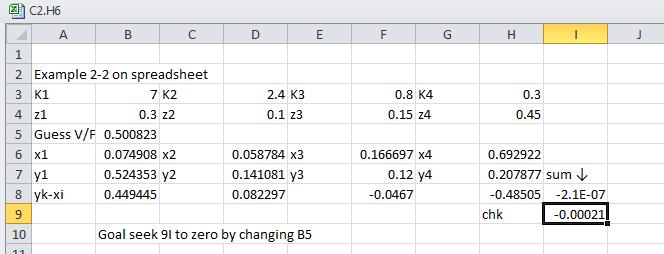SPE 4th Edition Solution Manual Chapter 2.
New Problems and new solutions are listed as new immediately after the solution number. These new problems are:2A8, 2A10 parts c-e, 2A11,2A12, 2A13, 2A14, 2C4, 2D1-part g, 2D3, 2D6, 2D7, 2D11, 2D13, 2D14, 2D20, 2D22, 2D23, 2D31, 2D32, 2E3, 2F4, 2G2, 2G3, 2H1, 2H3, 2H4, 2H5 and 2H6.
2.A1. Feed to flash drum is a liquid at high pressure. At this pressure its enthalpy can be calculated as a liquid. eg.
. When pressure is dropped the mixture is above its bubble point and is a two-phase mixture (It “flashes”). In the flash mixture enthalpy is unchanged but temperature changes. Feed location cannot be found from TF and z on the graph because equilibrium data is at a lower pressure on the graph used for this calculation.
2.A2. Yes.
2.A3. The liquid is superheated when the pressure drops, and the energy comes from the amount of superheat.
2.A4.
2.A4 zw = 0.965
2.A6. In a flash drum separating a multicomponent mixture, raising the pressure will: i. Decrease the drum diameter and decrease the relative volatilities. Answer is i.
2.A8. New Problem in 4th ed.
a. At 100oC and a pressure of 200 kPa what is the K value of n-hexane? 0.29
b. As the pressure increases, the K value
a. increases, b. decreases, c. stays constant b
c. Within a homologous series such as light hydrocarbons as the molecular weight increases, the K value (at constant pressure and temperature)
a. increases, b. decreases, c. stays constant b
d. At what pressure does pure propane boil at a temperature of -30oC? 160 kPa
2.A9. a. The answer is 3.5 to 3.6
b. The answer is 36ºC
c. This part is new in 4th ed. __102oC
2.A10. Parts c, d, and e are new in 4th ed. a. 0.22; b. No; c. From y-x plot for Methanol x = 0.65, yM = 0.85; thus, yW = 0.15. d. KM = 0.579/0.2 = 2.895, KW = (1 – 0.579)/(1 – 0.2) = 0.52625. e. αM-W = KM/KW = 2.895/0.52625 = 5.501.
2.A11. New problem in 4th edition. Because of the presence of air this is not a binary system. Also, it is not at equilibrium.
2.A12. New problem in 4th edition. The entire system design includes extensive variables and intensive variables necessary to solve mass and energy balances. Gibbs phase rule refers only to the intensive variables needed to set equilibrium conditions.
2A13. New problem in 4th edition. Although V is an extensive variable, V/F is an intensive variable and thus satisfies Gibbs phase rule.
2A14. New problem in 4th edition. 1.0 kg/cm2 = 0.980665 bar = 0.96784 atm.
Source: http://www.unit-conversion.info/pressure.html
2.B1. Must be sure you don’t violate Gibbs phase rule for intensive variables in equilibrium. Examples:
F,z,T,Pdrumdrum
F,z,y,Pdrum
F,z,x,p
F,z,y,p
drum
drum
F,z,x,Tdrum
Drum dimensions, z,F,drumdrum p
Drum dimensions, z,y,pdrum
etc.
F F,T,z,p F F,h,z,p
F F,T,z,y F F,h,z,y
F,T,z,x etc.
F
F,T,z,T,Fdrumdrum p
F F,T,y,p
F,T,y,TFdrum
F,T,x,p
F
F,T,x,TFdrum
F F,T,y,x
2.B2. This is essentially the same problem (disguised) as problem 2-D1c and e but with an existing (larger) drum and a higher flow rate.
With y = 0.58, x = 0.20, and V/F = 0.25 which corresponds to 2-D1c.
If lb mole F1000, D.98 and L 2.95 ft from Problem 2-D1e hr
Since D α V and for constant V/F, V α F, we have D α F
With F = 25,000:
FF=newoldnewoldnewnew 5, D = 5 D = 4.90, and L= 3 D = 14.7 . Existing drum is too small.
2.C5.
Feed rate drum can handle: F α D2
existing F16,660 lbmol/h
Alternatives
a) Do drums in parallel. Add a second drum which can handle remaining 8340 lbmol/h.
b) Bypass with liquid mixing
(16660) = 4150
Since x is not specified, use bypass. This produces less vapor.
c) Look at Eq. (2-62), which becomes
Bypass reduces V
c1) Kdrum is already 0.35. Perhaps small improvements can be made with a better demister → Talk to the manufacturers.
c2) ρv can be increased by increasing pressure. Thus operate at higher pressure. Note this will change the equilibrium data and raise temperature. Thus a complete new calculation needs to be done.
d) Try bypass with vapor mixing.
e) Other alternatives are possible.
Then ii iii i Kz yKx
From
2.C4. New Problem. Prove that the intersection of the operating and y = x lines for binary flash distillation occurs at the mole fraction of the feed.
SOLUTION: LF yyz VV ,rearrange:
the result is y
and therefore
The intersection is at the feed composition.
2.C7.
(2-18)
From data in Example 2-2 obtain:
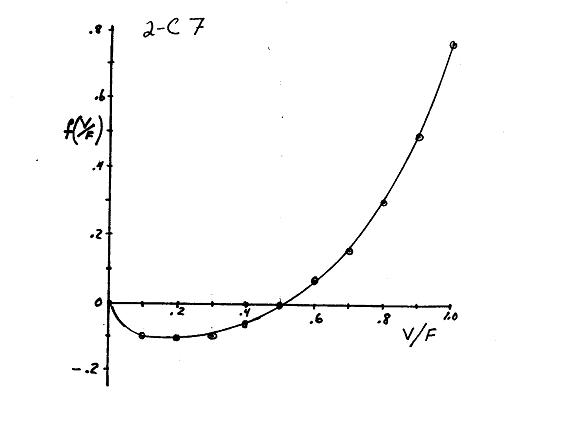
2.C8. Derivation of Eqs. (2-62) and (2-63). Overall and component mass balances are, FVLL12 and i1i,L12i,L2i FzLxLxVy
Substituting in Eqs. (2-60b) and 2-60c)
i1i,L1L2i,L22i,L2iVL2i,L2 FzLKxLxVKx
Solving, ii i,L2 1i,L22i,VL21i,L1L21i,VL2 FzFz x LKLVKLKFVLVK
Dividing numerator and denominator by F and collecting terms.
Since yKxii,VL2i,L2 ,
Stoichiometric equations, CCCC i,L2iii,L2 i1i1i1i1 x1 , y1 , thus, yx0
which becomes
Since
i,liq1i,L1L2i,liq2i,liq1
In addition,
2.D1. a. V0.410040 and LFV60 kmol/h
Slope op. line LV32, yxz0.6
See graph. y0.77 and x0.48
b. V0.41500600 and L900 . Rest same as part a.
c. Plot x0.2 on equil. Diagram and intercept yxz0.3. yzFV1.2
VFz1.20.25 . From equil y0.58
d. Plot x0.45 on equilibrium curve. LFV1VF.8 Slope 4 VVVF.2
Plot operating line, yxz at z0.51 . From mass balance F37.5 kmol/h.
e. Find Liquid Density.
MWxMWxMW.232.04.818.0120.82
L LLMWV20.8222.510.925 g/ml
Vapor Density: ρV = p(MW)V,avg/RT (Need temperature of the drum)
MWyMWyMW.5832.04.4218.0126.15 g/mol
Find Temperature of the Drum T: From Table 3-3 find T when y.58, x20, T=81.7C354.7K
4 v ml atm 1 atm26.15 g/mol82.0575354.7 K8.9810 g/ml mol K
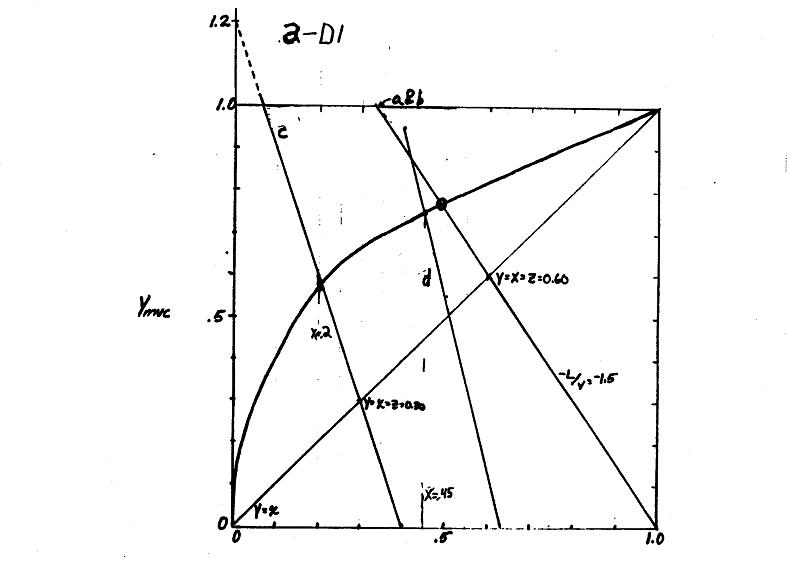
Find Permissible velocity:
ft. Use 2 ft diameter. L ranges from 3D6 ft to 5 D=10 ft
Note that this design is conservative if a demister is used.
f. Plot T vs x from Table 3-3. When T77C, x0.34, y0.69.
This problem is now very similar to 3-D1c. Can calculate V/F from mass balance, FzLxVy. This is
g. Part g is a new problem. V = 16.18 mol/h, L = 33.82, y= 0.892, x = 0.756.
2-D2. Work backwards. Starting with x2, find y2 = 0.62 from equilibrium. From equilibrium point plot op. line of slope
Find 21 z0.51x (see Figure). From equilibrium, 1 y0.78 .For stage 1, 11 11 zx V0.550.51 0.148
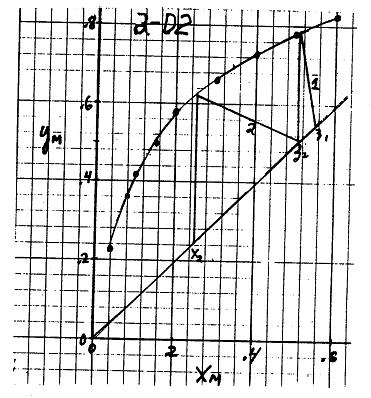
2.D3. New Problem in 4th edition.. Part a.
b. See Figure. a. If 1 bubble of vapor product (V/F = 0) vapor product, vapor yE = 0.7492 (highest) liquid xE = zE = 0.20 (highest) and T = 18.26 oC. If 1 drop of liquid product (V/F =1) yE = zE = 0.20 (lowest), xE = 0.035, T (by linear interpolation) ~ 56.18 + [(49.57 – 56.18)/(.297.161)][.2 – 0.16] = 54.2 oC (highest).
c. See figure. Slope = -L/V = - (1 – V/F)/(V/F) = - .6/.4 = - 1.5. xE = 0.12, yE = 0.57, T = 33.4oC.
d. From equilibrium data yE = 0.7492. For an F = 1, L = 1 – V, Ethane balance: .2L = 1(.3) –0.7492 V. Solve 2 equations: V/F = 0.1821. Can also find V/F from slope of operating line.
e. If do linear interpolation on equilibrium data, x = 0.05 +(45-49.57)(0.1 -0.05)/(37.57 – 49.57) = 0.069. From equilibrium plot y = 0.375.
Mass balance for basis F = 1, L = 1 – V and 0.069 L = 0.18 – 0.375 V. Solve simultaneously, V/F = 0.363.
2.D4. New problem in 3rd edition. Highest temperature is dew point
VF0
If pick C4 as reference: First guess butane K1.0, T41C
Guess for reference:
Note: hexane probably better choice as reference.
a)
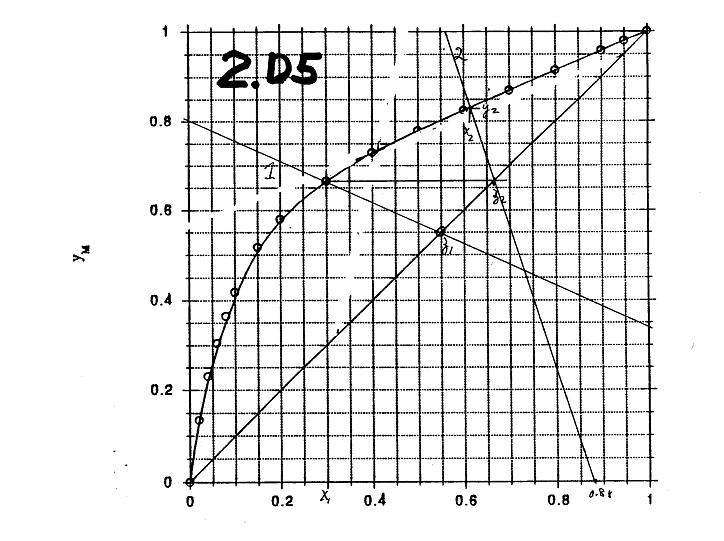
2.D6. New problem in 4th ed. a.) The answer is VP = 19.30 mm Hg
1310.62
logVP6.83791.2856 100136.05
10
b.) The answer is K = 0.01693.
2.D7. New problem 4th ed.
tot VP19.30 K P1.5760
Part a. Drum 1: V1/F1 = 0.3, Slope op line = -L/V = -.7/.3 = -7/3, y=x=z1 =0.46. L1 = F2 = 70.
From graph x1 = z2 = 0.395
Drum 2: V1/F1 = 30/70, Slope op line = -L/V = -7/3, y=x=z2 =0.395. L1 = F2 – V2 = 40.
From graph x2 = 0.263
Part b. Single drum: V/F = 0.6, Slope op line = -L/V = -40/60 = -2/3, From graph x = 0.295. More separation with 2 drums.
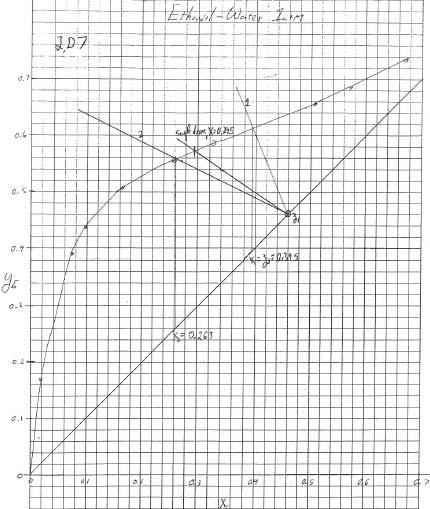
2.D8. Use Rachford-Rice eqn:
ii i K1z V f0 F1K1V/F
. Note that 2 atm = 203 kPa.
Find i K from DePriester Chart: K73,123 K4.1 K.115
Converge on
VF.076, VFVF152 kmol/h, LFV1848 kmol/h
From i i i z x V 1K1 F
we obtain x.0077,123 x.0809, x.9113
From yKx,iii123 we obtain y.5621, y.3649, y.1048
2.D9. Need hF to plot on diagram. Since pressure is high, feed remains a liquid
L FPFrefref hCTT, T0 from chart LEtOHw PPEtOHPw CCxCx Where EtOHw x and x are mole fractions. Convert weight to mole fractions.
Basis: 100 kg mixture: 30 30 kg EtOH0.651 kmol 46.07
70 kg water 7018.0163.885 Total = 4.536 kmol
Avg. 100 MW22.046 4.536 Mole fracs: Ew 0.6512 x0.1435, x0.8565 4.536
Use LEtOH CPP at 100C as an average C value.
F h0.9462000189.2 kcal/kg which can now be plotted on the enthalpy composition diagram. Obtain T88.2drumEE C, x0.146, and y0.617
. For F1000 find L and V from F = L + V and FzLxVy which gives V = 326.9, and L = 673.1
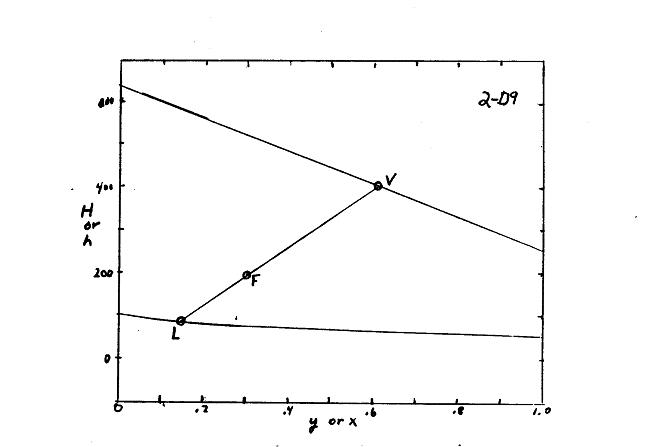
Note: If use wt. fracs. LL C23.99PPavg & CMW1.088 F and h217.6 . All wrong. 2.D.10 Solution 400
From DePriester chart
2 equations & 2 unknowns. Substitute in for C6 z . Do in Spreadsheet. Use Goal – Seek to find VF. V/F = 0.594 when R.R. equation 0.000881 .
2.D11. New Problem 4th ed. Obtain K ethylene = 2.2, K propylene = 0.56 from De Priester chart.
KE = yE/xE and KP = yP/xP Since yp = 1 – yE and xp = 1 – xE , Kp = (1 – yE)/(1 – xE).
Thus, 2 eqs and 2 unknowns. Solve for yE and xE.
xE = (1 – Kp) / (KE – Kp) and yE = KE xE = KE (1 – Kp) / (KE – Kp) xE = (1 – 0.56) / (2.2 – 0.56) = 0.268 and yE = KE xE = (2.2)(0.268) = 0.590
Check: xp = 1 – xE = 1 – 0.268 = 0.732 and yp = 1 – yE = 1 – 0.590 = 0.410 Kp = yp/xp = 0.410/ 0.732 = 0.56 OK
2.D12. For problem 2.D1c, plot x = 0.2 on equilibrium diagram with feed composition of 0.3. The resulting operating line has a y intercept zV/F1.2 . Thus VF0.25 (see figure in
Solution to 2.D1) Vapor mole fraction is y = 0.58.
Find Liquid Density.
Find Vapor Density.
Find Temperature of the Drum T:
Find Permissible velocity:
2.D13. New Problem 4th ed. xbutane = 1 – xE = 0.912, ybutane = 1 – yE = 0.454. KE = yE/xE = 0.546/0.088 = 6.20, Kbutane = yB/xB = 0.454/0.912 = 0.498.
Plot KE and Kbutane on DePriester chart. Draw straight line between them. Intersections with T and P axis give Tdrum = 15 oC, and pdrum = 385 kPa from Figure 2-12. Use mass balances to find V/F: F = L + V and FzE = LxE + VyE. Substitute L = F – V into ethane balance and divide both sides by F. Obtain: z = (1 – V/F)x + y(V/F).
Solve for V/F = (z-x)/(y-x) = (0.36 – 0.088)/(0.546 – 0.088) = 0.594. Spreadsheet used as a check (using T=15 and p = 385) gave V/F = 0.593.
2.D14. New Problem 4th ed. DePriester chart, Fig. 2-12: KC1 = 50, KC4 = 1.1, and KC5 = 0.37; z1 = 0.12, z4= 0.48, z5 = 0.40
Rachford-Rice equation:
Equation becomes: 5.880.0480.252 0 149(/)10.1(/)10.63(/) VFVFVF
Trials: V/F = 0.4, Eq. = -.005345; V/F = 0.39, Eq. = 0.004506; V/F = 0.394, Eq. = 0.000546, which is close enough with DePriester chart.
Liquid mole fractions: xC4 = 0.4618, xC5 = 0.5321, and ∑xi = 0.9998
C1
C1 C1 z .12 x0.00591; 1K1(V/F)149.394
Vapor mole fractions: yi = Ki xi : yC1 = 50(0.00591) = 0.2955, yC4 = 0.5080, yC5 = 0.1969, ∑yi = 1.0004.
2.D15. This is an unusual way of stating problem. However, if we count specified variables we see that problem is not over or under specified. Usually V/F would be the variable, but here it isn’t. We can still write R-R eqn. Will have three variables: zC2, ziC4, znC4. Need two other eqns: zziC4nC4C2iC4nC4 constant, and zzz1.0
Thus, solve three equations and three unknowns simultaneously.
Do It. Rachford-Rice equation is,
Can solve for zC2 = 1 – ziC4 and ziC4 = (.8) znC4. Thus zC2 = 1 – 1.8 znC4 Substitute for ziC4 and zC2 into R-R eqn.
Can now find K values and plug away. KC2 = 2.92, KiC4 = .375, KnC4 = .26. Solution is znC4 = 0.2957, ziC4 = .8 (.2957) = 0.2366, and zC2 = 0.4677
2.D16. z0.5,C1C4C5C6C1C4C5C6 z0.1, z0.15, z0.25, K50, K.6, K.17, K0.05
1st guess. Can assume all C1 in vapor, ~ 1/3 C4 in vapor, C5 & C6 in bottom
This first guess is not critical. R.R.
Similar for other components.
2-D17. a. V0.4F400, L600 Slope LF1.5
Intercepts y = x = z = 0.70. Plot line and find xA = 0.65, yA = 0.77 (see graph)
b. V = 2000, L = 3000. Rest identical to part a.
c. Lowest xA is horizontal op line (L = 0). xA = 0.12 Highest yA is vertical op line (V = 0). yA = 0.52. See graph
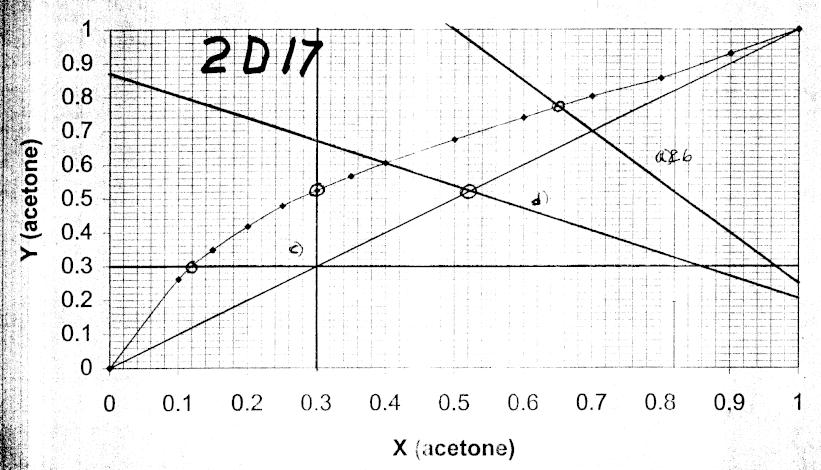
d. V = 600, L = 400, -L/V = -0.667. Find xA = 0.40 on equilibrium curve. Plot op line & find intersection point with y = x line. zA = 0.52
2.D18. From
, we obtain h h h z 1 x V FK1
Guess Tdrum , calculate K,hbp K and K, and then determine VF .
Check:
Initial guess: Tdrum must be less than temperature to boil pure hexane
h K1.0, T94C . Try 85°C as first guess (this is not very critical and the calculation will tell us if there is a mistake). K=0.8,hbp K4.8, K=11.7 . 0.6 1 V 0.85 1.471 F0.81 . Not possible. Must have h 0.6 K0.706 0.85
Try T73C where h K0.6 . Then K3.8,bpK9.9 . 0.6 1 V .85 0.735 F.61
Check:
ii i K1z8.9.12.8.3.4.6 0.05276 1K1VF18.9.73512.8.7351.4735
Converge on T~65.6C and VF~0.57
2.D19. 90% recovery n-hexane means
0.9FzLxC6C6
Substitute in LFV to obtain
C8 balance:
C6C6 z.91VFx
C6C6C6C6C6C6 zFLxVyFVxKVx or
C6C6C6C6 z1VFxxKVF
Two equations and two unknowns. Remove C6 x and solve
C6 C66 .9zKVF
Solve for
Trial and error scheme. Pick T, Calc
If not
K, Calc VF, and Check fVF0 ?
refold
KT K 1d fT
Try C4C5C6ref T70C. K3.1, K.93, K.37K
Rachford Rice equation
Converge on T~57C.NewC4C8 Then K2.50, K.67, and VF0.293
2.D20. New Problem 4th ed.
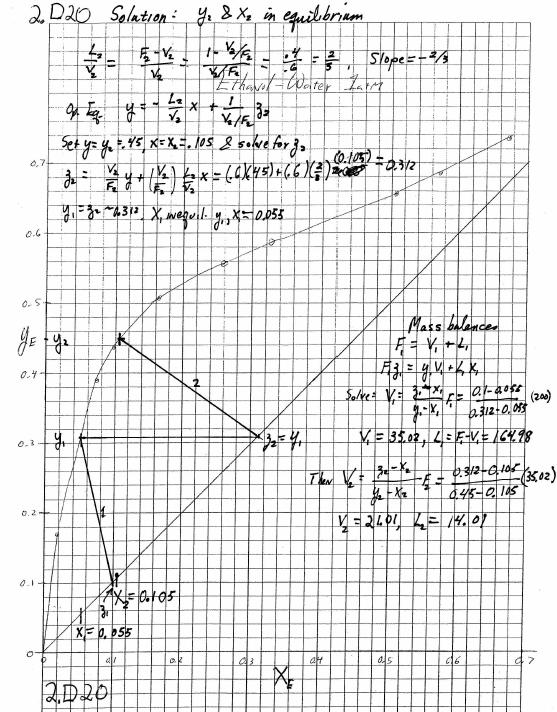
2.D22. New problem in 4th edition. a. V = F – L = 50 – 20 = 20 kmol/h. V/F = 3/5, Slope operating line = -L/V = -20/30 = - 2/3, zM = 0.7
From graph, y = 0.8, x = 0.54.
b. From graph of T vs. xM, Tdrum = 72.3oC. (see graph).
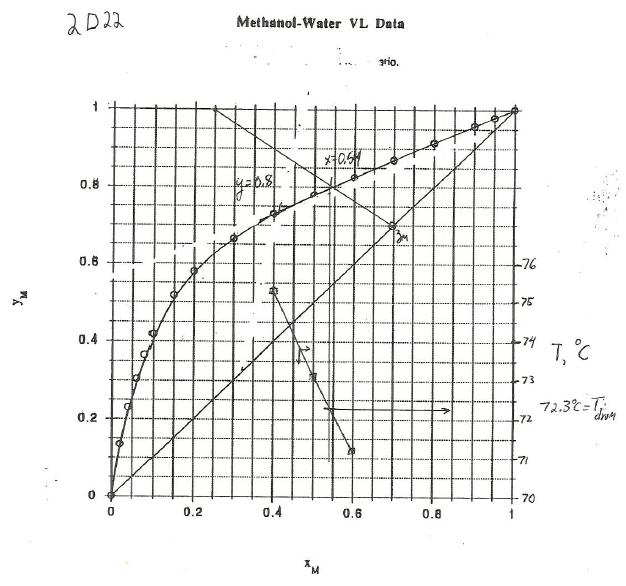
2.D23. New Problem 4th ed.
Part a. Fnew = (1500 kmol/h)(1.0 lbmol/(0.45359 kmol)) = 3307 lb mol/h.
V, WV, L, and WL are the values in Example 2-4 divided by 0.45359. The conversion factor divides out in Flv term. Thus, Flv, Kdrum, and uperm are the same as in Example 2-4. The Area increases because V increases: Area = AreaExample 2-4/0.45359 = 16.047/0.45359 = 35.38 ft2
4/6.71
Probably round this off to 7.0 feet and use a drum height of 28 feet.
b. Fparallel = 3307 – 1500 = 1807 lbmol/h.
Flv, Kdrum, and uperm are the same as in Example 2-4. Vparallel = (V/F) Fparallel = 0.51 (1807) = 921.6 kmol/h.
2 _24 16.04716.047(921.6/765)19.33 parallel c Example V A ft V
Then, 4/4.96 DiameterAreafeet , Use a 5.0 feet diameter and a length of 20 feet.
2.D24. p = 300 kPa At any T. KyxC3C3C3 , K’s are known.
C6C6C6C3C3 Kyx1y1x
Substitute 1st equation into 2nd
Solve for xC3,
At 300 kPa pure propane
At 300 kPa pure n-hexane
Check: at -14°C
Pick intermediate temperatures, find
boils at -14°C (Fig. 2-10)
0ºC1.450.027 0.9915
10ºC2.10.0440.4650.976See 20ºC2.60.0690.3680.956Graph
30ºC3.30.1050.2800.924
40ºC3.90.150.2270.884
50ºC4.70.210.1760.827
60ºC5.50.290.1360.75
70ºC6.40.380.1030.659
b. C3 x0.3 , VF0.4, LV0.60.41.5
Operating line intersects yx0.3, Slope 1.5
LF yxz VV
at F0.3 x0, yz0.75 V0.4
Find yc3 = 0.63 and xC3 = 0.062
Check with operating line:
0.631.5.0620.750.657
OK within accuracy of the graph.
c. Drum T: C3C3C3 Kyx0.630.06210.2 , DePriester Chart T = 109ºC
d. y.8, x~.16 Ly.8.6 Slope0.45 Vx.16.6
V/F = f =1/1.45 = 0.69








2.D25. 20% Methane and 80% n-butane. drum T.50 ºC , V 0.40 F , Find pdrum
b.)
2.D26. a) Can solve for L and V from M.B. 100 = F = V + L 45Fz0.8V0.2162L Find: L = 59.95 and V = 40.05
b) Stage is equil.
These K values are at same T, P. Find these 2 K values on DePriester chart. Draw straight line between them. Extend to T,drumdrum p . Find 10ºC, 160 kPa.
2.D27. a.) C510
1064.8 VP: log VP6.8532.2832 0233.01
, VP191.97 mmHg b.) VP37602280 mmHg
, 10 logVP
Solve for T = 71.65ºC
c.) tot P191.97 mm Hg [at boiling for pure component tot PVP ]
d.) C5: 10 1064.8 logVP6.8532.8045 30233.01 , VP637.51 mm Hg
mm Hg
10C6
If K&KAB are known, two eqns. with 2 unknowns K&yAA Solve.
Solve for L & V: L = 0.7099 & V = 0.2901 mol g.) Same as part f, except units are mol/min.
2.D28.
From example 2-4, x0.19,HdrumHH T378K, VF0.51, y0.6, z0.40 MWv = 97.39 lbm/lbmole (Example 2-4)
Example
160,0685585 V8603.8ft,h83.51ft and h/D = 6.5. 43.4160min/hD
2.D29. The stream tables in Aspen Plus include a line stating the fraction vapor in a given stream. Change the feed pressure until the feed stream is all liquid (fraction vapor = 0). For the Peng-Robinson correlation the appropriate pressure is 74 atm.
The feed mole fractions are: methane = 0.4569, propane = 0.3087, n-butane = 0.1441, i-butane = 0.0661, and n-pentane = 0.0242.
b. At 74 atm, the Aspen Plus results are; L = 10169.84 kg/h = 201.636 kmol/h, V = 4830.16 kg/h = 228.098 kmol/h, and Tdrum = -40.22 oC.
The vapor mole fractions are: methane = 0.8296, propane = 0.1458, n-butane = 0.0143, i-butane = 0.0097, and n-pentane = 0.0006.
The liquid mole fractions are: methane = 0.0353, propane = 0.4930, n-butane = 0.2910, i-butane = 0.1298, and n-pentane = 0.0509.
c. Aspen Plus gives the liquid density = 0.60786 g/cc, liquid avg MW = 50.4367, vapor density = 0.004578 g/cc = 4.578 kg/m3, and vapor avg MW = 21.17579 g/mol = kg/kmol.
The value of uperm (in ft/s) can be determined by combining Eqs. (2-64), (2-65) and (2-69) Flv = (WL/WV)[
= (10169.84/4830.16)[0.004578/0.60786]0.5 = 0.18272
Resulting Kvertical = 0.378887 , Khorizontal = 0.473608, and uperm = 5.436779 ft/s = 1.657m/s
10169.84kg/h V(Vol rate)(hold time + surge time) = ()(9/60st) 607.86kg/m st607.86V/10169.849/600.103 hours6
2.D30.. a. From the equilibrium data if yA = .40 mole fraction water, then xA = 0.09 mole fraction water. Can find LA and VA by solving the two mass balances for stage A simultaneously. LA + VA = FA = 100 and LA (.09) + VA (.40) = (100) (.20). The results are VA = 35.48 and LA = 64.52.
b. In chamber B, since 40 % of the vapor is condensed, (V/F)B = 0.6. The operating line for this flash chamber is, y = -(L/V)x + FB/V) zB where zB = yA = 0.4 and L/V + .4FB/.6FB = 2/3. This operating line goes through the point y = x = zB = 0.4 with a slope of -2/3. This is shown on the graph. Obtain xB = 0.18 & yB = 0.54. LB = (fraction condensed)(feed to B) = 0.4(35.48) = 14.19 kmol/h and VB = FB – LB = 21.29.
c. From the equilibrium if xB = 0.20, yB = 0.57. Then solving the mass balances in the same way as for part a with FB = 35.48 and zB = 0.4, LB = 16.30 and VB = 19.18. Because xB = zA, recycling LB does not change yB = 0.57 or xA = 0.09, but it changes the flow rates VB,new and LA,new. With recycle these can be found from the overall mass balances: F = VB,new + LA,new and FzA = VB,newyB + LA,new xA. Then VB,new = 22.92 and LA,new = 77.08.
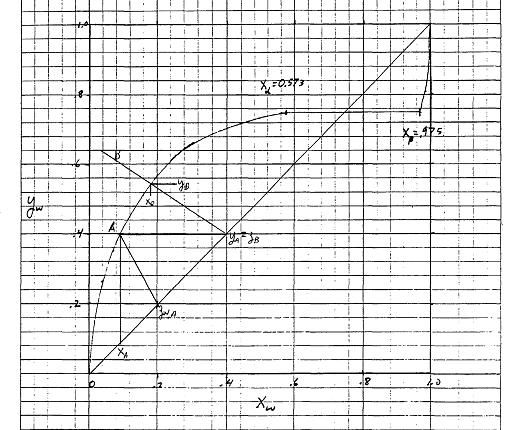
Graph for problem 2.D30.
2.D31. New problem in 4th US edition. Was 2.D13 in 3rd International Edition. a) Since K’s are for mole fractions, need to convert feed to mole fractions. Basis: 100 kg feed
DePriester Chart
Result similar if use Raoult's law.
NOT possible. Won’t flash at 0ºC.
2.D32. New problem in 4th US edition. Was 2.D28 in 3rd International Edition.
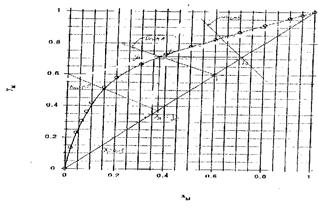
2.E1. From Aspen Plus run with 1000 kmol/h at 1 bar, L = V = 500 kmol/h, WL = 9212.78 kg/h, WV = 13010.57 kg/h, liquid density = 916.14 kg/m3 , liquid avg MW = 18.43, vapor density = 0.85 kg/m3 , and vapor avg MW = 26.02, Tdrum = 94.1 oC, and Q = 6240.85 kW.
The diameter of the vertical drum in meters (with uperm in ft/s) is
D = {[4(MWV) V]/[3600 π ρV uperm (1 m/3.281 ft)]}0.5 = {[4(26.02)(500)]/[3600(3.14159)(0.85)(1/3.281)uperm]}0.5
Flv = (WL/WV)[ρV/ ρL]0.5 = (9212.78/13010.57)[0.85/916.14]0.5 = 0.02157
Resulting Kvertical = 0.404299, and uperm = 13.2699 ft/s, and D = 1.16 m. Appropriate standard size would be used. Mole fractions isopropanol: liquid = 0.00975, vapor = 0.1903
b. Ran with feed at 9 bar and pdrum at 8.9 bar with V/F = 0.5. Obtain WL = 9155.07 kg/h, WV = 13068.27, density liquid = 836.89, density vapor = 6.37 kg/m3
D = {[4(MWV) V]/[3600 π ρV uperm (1 m/3.281 ft)]}0.5 = {[4(26.14)(500)]/[3600(3.14159)(6.37)(1/3.281)uperm]}0.5
Flv = (WL/WV)[ρV/ ρL]0.5 = (9155.07/13068.27)[6.37/836.89]0.5 = 0.06112
Resulting Kvertical = .446199, uperm = 5.094885 ft/s, and D = 0.684 m. Thus, the method is feasible.
c. Finding a pressure to match the diameter of the existing drum is trial and error. If we do a linear interpolation between the two simulations to find a pressure that will give us D = 1.0 m (if linear), we find p = 3.66. Running this simulation we obtain, WL = 9173.91 kg/h, WV = 13049.43, density liquid = 874.58, density vapor = 2.83 kg/m3, MWv = 26.10
D = {[4(MWV) V]/[3600 π ρV uperm (1 m/3.281 ft)]}0.5 = {[4(26.10)(500)]/[3600(3.14159)(2.83)(1/3.281)uperm]}0.5
Flv = (WL/WV)[ρV/ ρL]0.5 = (9173.91/13049.43)[2.83/874.58]0.5 = 0.0400
Resulting Kvertical = .441162, uperm = 7.742851 ft/s, and D = 0.831 m.
Plotting the curve of D versus pdrum and setting D = 1.0, we interpolate pdrum = 2.1 bar At pdrum = 2.1 bar simulation gives, WL = 9188.82 kg/h, WV = 13034.53, density liquid = 893.99 , density vapor = 1.69 kg/m3, MWv = 26.07.
D = {[4(MWV) V]/[3600 π ρV uperm (1 m/3.281 ft)]}0.5 = {[4(26.07)(500)]/[3600(3.14159)(1.69)(1/3.281)uperm]}0.5
Flv = (WL/WV)[ρV/ ρL]0.5 = (9188.82/13034.53)[1.69/893.99]0.5 = 0.0307
Resulting Kvertical = .42933, uperm = 9.865175ft/s, and D = 0.953 m.
This is reasonably close and will work OK. Tdrum = 115.42 oC, Q = 6630.39 kW, Mole fractions isopropanol: liquid = 0.00861, vapor = 0.1914
In this case there is an advantage operating at a somewhat elevated pressure.
2.E2. This problem was 2.D13 in the 2nd edition of SPE
a. Will show graphical solution as a binary flash distillation. Can also use R-R equation. To generate equil. data can use
Substitute for xC6
Pick T, find KC6 and KC8 (e.g. from DePriester charts), solve for xC6. Then yC6 = KC6xC6
Line Slope
See Figure. yC6 = 0.85 and xC6 = 0.52. Thus KC6 = .85/.52 = 1.63. This corresponds to T = 86°C = 359K
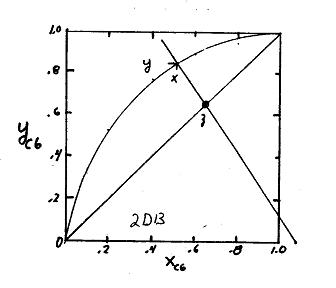
b. Follows Example 2-4.
Note: This uPerm is at 85% of flood. If we want to operate at lower % flood (say 75%)
Then at 75% of flood, ACs = 94.44 which is D = 10.96 or 11.0 ft.
2.E3. New problem 4th edition. The difficulty of this problem is it is stated in weight units, but the VLE data is in molar units. The easiest solution path is to work in weight units, which requires converting some of the equilibrium data to weight units and replotting – good practice. The difficulty with trying to work in molar units is the ratio L/V = 0.35/0.65 = 0.5385 in weight units becomes in molar units, () () vapor molarwt molarwtliquid MW LL VVMW , but x and y are not known the molecular weights are unknown.
In weight units, V = F(V/F) =2000 kg/h (0.35) = 700 kg/h. L = F – V = 1300 kg/h. In weight units the equilibrium data (Table 2-7) can be converted as follows:
Basis: 1 mol, x = 0.4 and y = 0.729, T = 75.3 C
Liquid: 0.4 mol methanol ×32.04 g/mol = 12.816 g 0.6 mol water × 18.016 g/mol = 10.806 g
Total = 23.622 g → x = 0.5425 wt frac methanol
Vapor: 0.729 mol methanol = 23.357 g 0.271 mol water = 4.881 g 28.238 g → y = 0.8271 wt frac methanol.
Similar calculations for: 0.3 mole frac liquid give xwt = 0.433 and ywt = 0.7793, T = 78.0 C
0.2 mole frac liquid give xwt = 0.3078 and ywt = 0.7099, T = 81.7 C
0.15 mole frac liquid give xwt = 0.2389 and ywt = 0.6557, T = 84.4 C.
Plot this data on ywt vs xwt diagram. Operating line is y = - (L/V)x +(F/V)z in weight units.
Slope = - 1.857, y =x = z = 0.45, and y intercept = z/(V/F) = 1.286 all in weight units.
Result is xM,wt = 0.309, yM,wt = 0.709 (see graph). Note that plotting only the part of the graph needed to solve the problem, the scale could be increased resulting in better accuracy. By linear interpolation Tdrum = 81.66 C.
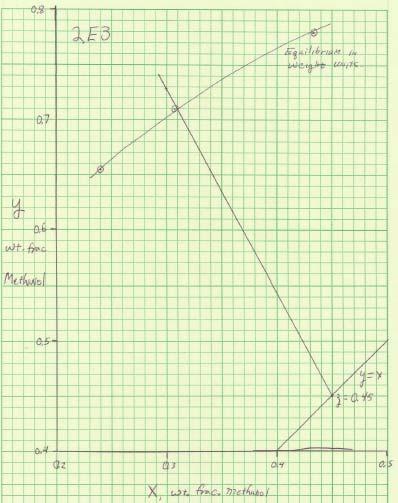
Benzene-toluene equilibrium is plotted in Figure 13-8 of Perry’s Chemical Engineers Handbook, 6th ed.
2.F2. See Graph. Data is from Perry’s Chemical Engineers Handbook, 6th ed., p. 13-12.
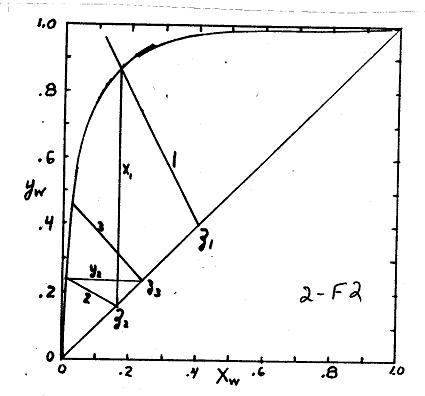
Stage 1) F1 23 z.4 f13 Slope2, 13
Stage 2) F2 13 z.164 f23 Slope12 23
Stage 3) F3 z.240 f12 Slope1
2.F3. Bubble Pt. At P = 250 kPa. Want 11 Kz1
.Solution uses DePriester chart for K values.
Guess 123 T18C, K1, K.043, K.00095, .52
Converge to T0C
Dew Pt. Calc. Want 1 1 z 1.0 K
Try 123 T0C, K1.93, K0.11, K0.0033, 120.26
Converge to T124C
. This is a wide boiling feed. Tdrum must be lower than 95°C since that is feed temperature.
First Trial: Guess T70C:d,1123 K7.8, K1.07, K.083
Guess VF0.5 . Rachford Rice Eq.
Data: Pick ref T25C
. (Perry’s 6th ed; p. 3-127), and (Perry’s 6th ed; p. 3-138) 1 81.76 cal/g 443597.44 kcal/kmol
2 87.54 cal/g 726302.88 kcal/kmol
For pL3 T20 to 123C, C65.89 kcal/(kmol C)
at pL2 T75C, C39.66 kcal/(kmol C)
(Himmelblau/Appendix E-7)
propane a = 16.26 b = 5.398 × 10-2 c = -3.134 × 10-5
a = 8.163 b = 140.217 × 10-3
-4.538 × 10-5
= -44.127 × 10-6 ** Smith & Van Ness p. 106 Energy Balance: E(Td) = VHv + LhL – FhF = 0
x.137,1231 x.101, x.762, x1.0000
Fh297,773;FLvdrum Lh90,459; VH209,999; ET2685
Thus Tdrum must be very close to 57.3°C. x.136,123 x.101, x.762 , y.328,123 y.081, y.041
V51.3 kmol/h, L48.7 kmol/h
Note: With different data Tdrum may vary significantly.
2.F4. New Problem 4th edition. This is a mass and energy balance problem disguised as a flash distillation problem. Data is readily available in steam tables.. At 5000 kPa and 500K the feed is a liquid, hF = 17.604 kJ/mol. For an adiabatic flash, hF = [VHV + LhL]/F
Vapor and liquid are in equilibrium. Saturated steam at 100 kPa is at T = 372.76K, hL = 7.5214 kJ/mol, HV = 48.19 kJ/mol
Mass balance: F = V + L where F in kmol/min = (1500 kg/min)(1 kmol/18.016 kg) = 83.259 kmol/min
EB: FhF = VHV + LhL → (83.259 kmol/min)(17.604 kJ/mol)(1000 mol/kmol) = (48.19)(1000)V + (7.5214)(1000)L. Solve equations simultaneously. L = 62.617 kmol/min = 1128.12 kg/min and V = 20.642 kmol/min = 371.88 kg/min
2.G1. Used Peng-Robinson for hydrocarbons.
Find drum T33.13C, L34.82 and V65.18 kmol/h
In order ethylene, ethane, propane, propylene, n-butane, xi (yi) are:
0.01220.0748, 0.08660.3005, 0.33180.3781, 0.03060.0404, 0.53880.2062.
2.G2. New problem in 4th edition. Part a. p = 31.26 kPa with V/F)feed = 0.0009903. Part b. Use pfeed = 31.76 kPa, V/F)feed = 0.0
Part c. Drum p = 3.9 bar, Tdrmu = 19.339, V/F = 0.18605, Liquid mole fractions: C1 = 0.14663, C2 = 0.027869 (∑ = 0.05253 is in spec), C5 = 0.6171, C6 = 0.3404. Vapor mole fractions: C1 = 0.68836, C2 = 0.20057, C5 = 0.9523, and C6 = 0.01584.
2.G3. New problem 4th edition. K values in Aspen Plus are higher by 17.6% (methane), 7.04% (nbutane) and 0.07% n-pentane. Since the K values are higher V/F is higher by 10.2%.
Results:
V/F)drum = 0.43419; V/F)feed = 0.3654; Q = -3183.4 cal/s
2.G4.
COMP x(I) y(I)
METHANE 0.12053E-010.84824
BUTANE 0.12978 0.78744E-01
PENTANE 0.29304 0.47918E-01
HEXANE 0.56513 0.25101E-01 V/F = 0.58354
2.G5. N. Used NRTL. T = 368.07, Q = 14889 kW, 1st liquid/total liquid = 0.4221, Comp Liquid 1, x1 Liquid 2, x2 Vapor, y
2.G6. Used Peng Robinson. Feed pressure = 10.6216 atm, Feed temperature = 81.14oC, V/F = 0.40001, Qdrum =0. There are very small differences in feed temperature with different versions of AspenPlus. COMP
V/F = 0.40001
2.H1. New Problem 4th ed A. 563.4 R, b.V/F = .4066. c. 18.264 psia
2.H3. New Problem. 4th ed. Answer V/F = 0.564; xE = 0.00853, xhex = 0.421, x hept = .570; yE = .421, y Hex = 0.378, y Hept = .201.
2H4. New Problem, 4th ed. Answer: pdrum = 120.01, kPa = 17.40 psia xB = 0.1561, xpen = 0.4255, x hept = 0.4184, yB = 0.5130, yPen = 0.4326 , yhept = 0.0544
2H5. New problem 4th ed.
a. SOLUTION. P = 198.52 kPa.
b. V/F = 0.24836, ethane x = 0.00337, y = 0.0824; Propane x =0.05069, y = 0.3539; Butane x= 0.1945, y = 0.3536; Pentane x = 0.3295, y = 0.1584; Hexane x = 0.3198, y = 0.0469 Heptane x = 0.1022, y = 0.00464
c. T = 34.48oC
d. T = -1.586oC and V/F = 0.0567
2H6. New problem in 4th ed.
